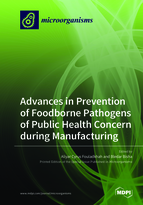Advances in Prevention of Foodborne Pathogens of Public Health Concern during Manufacturing
A special issue of Microorganisms (ISSN 2076-2607). This special issue belongs to the section "Food Microbiology".
Deadline for manuscript submissions: closed (31 August 2019) | Viewed by 49530
Special Issue Editors
Interests: antibiotic resistance, and antimicrobial interventions against foodborne bacterial pathogens; ecology of planktonic cells and biofilms of foodborne, enteric, waterborne, and environmental bacteria in landscape of climate change; foodborne diseases epidemiology
Special Issues, Collections and Topics in MDPI journals
Interests: food microbiology and microbial safety of foods; ecology of foodborne pathogens; rapid diagnostics; sample preparation; study of microorganisms at the single cell level; antimicrobial resistance; microbial source tracking
Special Issues, Collections and Topics in MDPI journals
Special Issue Information
Dear Colleagues,
According to a report from the U.S. Centers for Disease Control and Prevention (CDC), achieving safe and healthier foods is one of the top ten achievements of public health in the 20th century. However, considerable persisting challenges currently exists in developed nations and transition economies for further assuring the safety and security of the food chain. According to CDC estimates, as many as 3000 American adults, as an example, and based on a recent epidemiological estimate of the World Health Organization, around 420,000 individuals around the globe, lose their lives every year due to foodborne diseases. This emphasizes the need for innovative and emerging interventions, for further prevention or mitigation of the risk of foodborne microbial pathogens during food processing and manufacturing.
The current Special Issue will publish recent advancements and progress in the elimination and decontamination of microbial pathogens during various stages of manufacturing and production. Special emphasis will be placed on hurdle validation studies, investigating decontamination of serovars of non-typhoidal Salmonella, various serogroups of Shiga toxin-producing Escherichia coli, public health significant serotypes of Listeria monocytogenes, pathogenic species of Vibrio, and various species of Campylobacter, Cronobacter sakazakii, and Norovirus. Researchers and practitioners conducting original laboratory studies, epidemiological research, and critical review papers are cordially invited to submit a manuscript for this Special Issue of Microorganisms.
Dr. Aliyar Fouladkhah
Dr. Bledar Bisha
Guest Editors
Manuscript Submission Information
Manuscripts should be submitted online at www.mdpi.com by registering and logging in to this website. Once you are registered, click here to go to the submission form. Manuscripts can be submitted until the deadline. All submissions that pass pre-check are peer-reviewed. Accepted papers will be published continuously in the journal (as soon as accepted) and will be listed together on the special issue website. Research articles, review articles as well as short communications are invited. For planned papers, a title and short abstract (about 100 words) can be sent to the Editorial Office for announcement on this website.
Submitted manuscripts should not have been published previously, nor be under consideration for publication elsewhere (except conference proceedings papers). All manuscripts are thoroughly refereed through a single-blind peer-review process. A guide for authors and other relevant information for submission of manuscripts is available on the Instructions for Authors page. Microorganisms is an international peer-reviewed open access monthly journal published by MDPI.
Please visit the Instructions for Authors page before submitting a manuscript. The Article Processing Charge (APC) for publication in this open access journal is 2700 CHF (Swiss Francs). Submitted papers should be well formatted and use good English. Authors may use MDPI's English editing service prior to publication or during author revisions.
Keywords
- Microbial Food Safety
- Public Health Microbiology
- Food Microbiology
- Food Manufacturing and Processing
- Foodborne Diseases








